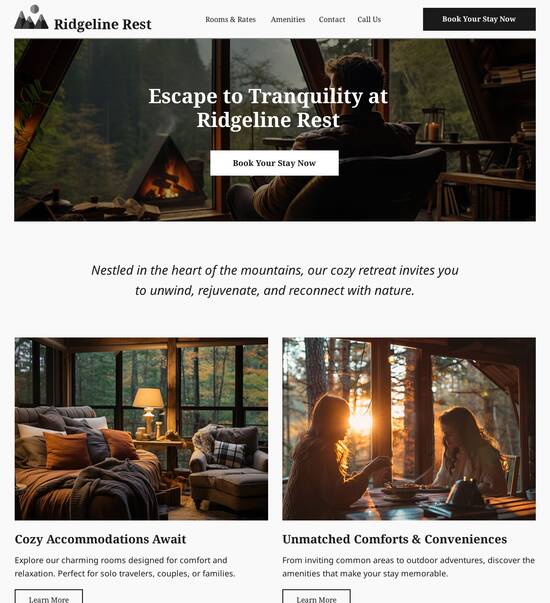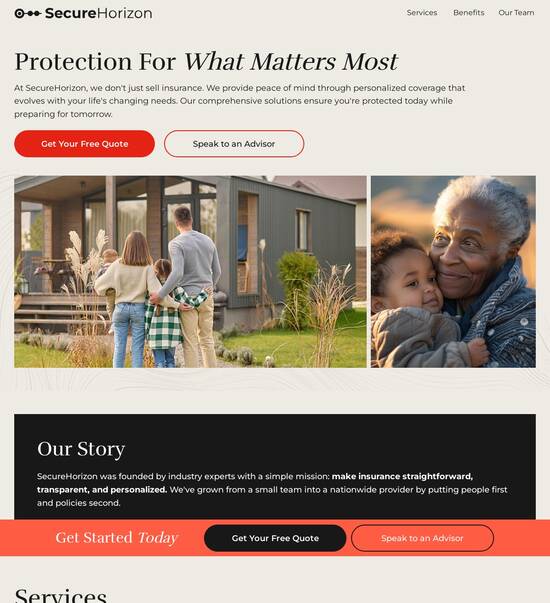
Storytelling HTML page templates
Use TemplateAbout template
Master the art of web design with storytelling HTML page templates. Transform your business today!
Recommended templates

Easy to build without coding
With the intuitive drag-and-drop builder, anyone on your team can create high-converting pages without any knowledge of code or design. Make enhancements to your landing page with custom widgets using Javascript, HTML/CSS, or third-party scripts.

Multiple layouts for any industry and goal
Select from 500+ landing page layouts built to boost conversions across industry-specific scenarios. Customize them by adjusting fonts, adding images, and generating on-brand content with the AI assistant. Quickly scale with Instablocks® and Global Blocks that you can save, reuse, and update globally.

Loads fast and looks polished on any device
Every template is responsive, which means they present professionally on any device and load blazingly fast with our Thor Render Engine. You can also power them up with Google AMP technology to deliver an unparalleled mobile experience and drive higher conversions.

Robust analytics & experimentation
Get real-time updates and reporting across all your devices, showing the number of visitors, conversions, cost-per-visitor, and cost-per-lead. Launch AI-powered experiments, run A/B tests, and use heatmaps to analyze user behavior, then optimize your landing page to maximize conversions.







Easy to build without coding
With the intuitive drag-and-drop builder, anyone on your team can create high-converting pages without any knowledge of code or design. Make enhancements to your landing page with custom widgets using Javascript, HTML/CSS, or third-party scripts.
Multiple layouts for any industry and goal
Select from 500+ landing page layouts built to boost conversions across industry-specific scenarios. Customize them by adjusting fonts, adding images, and generating on-brand content with the AI assistant. Quickly scale with Instablocks® and Global Blocks that you can save, reuse, and update globally.
Loads fast and looks polished on any device
Every template is responsive, which means they present professionally on any device and load blazingly fast with our Thor Render Engine.
Robust analytics & experimentation
Get real-time updates and reporting across all your devices, showing the number of visitors, conversions, cost-per-visitor, and cost-per-lead. Launch AI-powered experiments, run A/B tests, and use heatmaps to analyze user behavior, then optimize your landing page to maximize conversions.
All the features you need to build story website template
Explore more featuresLearn how to build storytelling with environments from brainstorming to rendering
Frequently asked questions about storytelling with environments from brainstorming to rendering free
Leading the way in building high-performing landing pages





Story telling templates: Your ultimate how-to guide
Maximizing the efficacy of your digital marketing campaigns is crucial in today's competitive landscape. Instapage provides marketers across various verticals such as business services, tech, education, and financial services with essential tools to create high-converting landing pages effortlessly. With over 100 templates and lead generation elements, marketers can launch campaigns quickly, enabling them to capture leads and drive substantial results without technical expertise.
The benefits of using Instapage for landing pages
Instapage stands out due to its flexibility and user-friendly nature. Users can create landing pages rapidly through a library of conversion-focused layouts and Instablocks, all without needing developers or coding knowledge. This not only speeds up the launch of marketing campaigns but also ensures that the pages are optimized for conversions right from the start.
- Access to over 100 ready-to-use templates that cater to various business needs, each designed for high conversion.
- The ability to easily drag and drop lead generation elements, making page creation intuitive and efficient.
- Comprehensive A/B testing features that allow users to continually assess and improve their landing pages.
Steps to create high-converting landing pages
Creating impactful landing pages with Instapage involves a few key steps that any marketer can follow:
- Choose a template that aligns with your brand and goals. Select a design from over 100 available options tailored for various campaigns and industries.
- Utilize the intuitive design tools to customize your page’s elements, ensuring that the content resonates with your target audience.
- Implement A/B testing to compare different versions of your page and gain insights on the most effective variations.
Optimization for better conversion rates
To truly maximize the performance of your landing pages, ongoing optimization is essential. Key strategies include:
- Use built-in heatmaps to analyze user interactions on your page, identifying areas for improvement.
- Leverage audience-level tracking to measure engagement metrics and adjust your content for different customer segments.
- Conduct regular A/B tests to refine your messaging, calls to action, and design elements based on real user feedback.
In conclusion, adopting Instapage not only improves the speed of landing page creation but also enhances the overall effectiveness of your digital marketing strategy.
Start maximizing your marketing ROI today with Instapage's comprehensive tools designed for marketers of all backgrounds. Create, optimize, and scale your campaigns with ease.
People also ask about storytelling with environments from brainstorming to rendering free download
The art of storytelling with HTML page templates
Understanding the essence of storytelling in web design
Storytelling is a crucial framework in digital spaces, revolutionizing how information is shared and absorbed. It goes beyond mere presentation of facts; it ties together components of a narrative to convey a message effectively. The importance of storytelling in communication cannot be overstated—it allows brands to connect with their audience on a personal level. By packaging information within a story, it becomes more relatable and instinctively guides users through content.
The psychological impact of storytelling is profound. Research indicates that narratives are not just memorable—they also evoke emotions, making users more likely to engage with content. This emotional resonance, paired with the structured flow of a story, keeps users intrigued and encourages them to explore further, thus enhancing retention and interaction rates.
Why use a storytelling HTML page template?
Using a storytelling HTML page template transforms how messages are delivered and perceived. One of the most significant advantages of these templates is their ability to enhance user experience via a narrative structure. By guiding visitors through a journey, it creates an engaging experience that can lead to a more profound understanding of the message being conveyed.
Building emotional connections is another critical aspect of using storytelling templates. Audiences respond better to content that resonates with their experiences or emotions. The deeper the emotional tie, the more likely users are to return and act upon the information provided. In fact, studies have shown that a well-told story can increase user retention rates by over 60% and significantly boost conversion rates.
Key features of storytelling HTML page templates
Storytelling HTML page templates come equipped with several unique features that enhance their effectiveness. One of the most notable features is visual storytelling through design elements. Visuals like images, videos, and animations play a pivotal role in enriching narratives; they engage users and support the storyline. Effective visual storytelling examples can be seen in top landing pages where powerful imagery and succinct video content work together to capture attention.
Moreover, a structured narrative layout ensures the content has a clear beginning, middle, and end. This organization helps users navigate the story effortlessly. Essential components, such as headlines and subheadings, direct the user's experience, breaking complex narratives into digestible parts. Additionally, including call-to-action elements at critical junctures keeps users informed on what actions to take next.
Responsive and adaptive design
In our multi-device world, responsive design is vital for storytelling HTML page templates. These templates must maintain narrative integrity across devices, ensuring the story remains appealing, no matter the screen size. An audience’s engagement can diminish quickly if the storytelling experience falters on a mobile device.
Techniques to achieve responsive design include fluid grids and flexible images, which allow content to adjust to different screen sizes seamlessly. Testing templates across devices is also essential in confirming that all design elements function in harmony, thus providing a consistent user experience.
Technical aspects of storytelling HTML page templates
The foundation of effective storytelling lies in its HTML structure. Utilizing recommended semantic HTML elements can significantly enhance the storytelling aspect. For instance, headers, paragraphs, and layout elements should be organized meaningfully to improve readability. Accessibility is paramount; it ensures that the narratives can be enjoyed by all users, regardless of disabilities.
To add interactivity, JavaScript can enhance user engagement dramatically. Functions like `document.addEventListener` allow you to create dynamic elements within the story that respond to user interactions. Examples of such events include initiating animations when a user scrolls or clicking a button to reveal additional content. Importantly, the DOMContentLoaded event is crucial in establishing a smooth user experience by ensuring that scripts run only after the HTML has been fully loaded.
Crafting engaging content with storytelling HTML page templates
Engaging content is central to successful storytelling. As you create narratives, it is essential to focus on hooks that draw in the audience immediately. Hook strategies can range from thought-provoking questions to relatable scenarios that make users feel understood. Moreover, relatable characters enhance users’ emotional investment in the story, leading to more profound connections.
Pacing also plays a crucial role in digital storytelling. The right mix of tension and release within narratives can keep users hooked. Riding the fine line between leaving them wanting more while providing enough information to satisfy their curiosity increases the likelihood of action.
Incorporating user feedback is vital. Polls, quizzes, and other interactive elements encourage users to participate actively in storytelling. This interaction not only makes the experience more engaging but also provides valuable insights you can use to refine future narratives. Additionally, leveraging user-generated content fosters authenticity, adding a personal touch that can enhance the overall narrative.
Optimization and performance considerations
To maximize the effectiveness of storytelling HTML pages, it is crucial to implement SEO best practices. Proper keyword optimization is vital, but it shouldn’t compromise the flow of the narrative. Strategic placement of keywords in headings, subheadings, and throughout the body text helps ensure that the content remains visible to search engines while resonating with the audience.
Performance is equally important—minimizing load times ensures users remain engaged rather than frustrated by delays. Techniques such as image compression, code minification, and asynchronous loading of scripts can dramatically improve page speed. Additionally, utilizing tools to assess performance helps identify areas for further enhancement.
Case studies: success stories of storytelling HTML implementations
Examining inspiring examples of successfully implemented storytelling HTML pages reveals valuable lessons. Several brands have effectively used storytelling to convert visitors into loyal customers. These landing pages leverage narratives that resonate with their target audience, integrating strong visuals with content that guides users toward a specific goal.
Metrics of success are often starkly visible. Companies that adopt storytelling tactics in their landing pages see observable boosts in conversion rates. For instance, conversion rates can improve by 30% or more simply by employing engaging narratives. Additionally, user engagement statistics often reflect longer time spent on the page when effective storytelling is utilized.
Future trends in storytelling and HTML page design
As technology continues to evolve, storytelling techniques are also changing. The future versions of storytelling HTML page templates are likely to incorporate advanced tech such as augmented reality (AR) and virtual reality (VR), providing immersive experiences that traditional designs cannot replicate. This evolution indicates an exciting shift towards more interactive and engaging narratives.
However, challenges persist. With the rapid evolution, staying relevant is a concern for many marketers. User experience must continuously evolve to meet changing expectations. Addressing these needs involves embracing a culture of experimentation and adaptation, ensuring that brands remain aligned with audience preferences.
Crafting your own storytelling HTML page template
Creating an effective storytelling HTML page template begins with careful planning. Start by outlining your narrative structure—this should include a clear beginning, middle, and end. With an outline in place, select appropriate design elements that align with your brand’s voice and the message being conveyed.
Once the planning is complete, basic coding for storytelling templates can commence. Utilize semantic HTML to foster an inclusive experience while employing CSS for styling. JavaScript can be added to boost interactivity. Testing your template across different devices and browsers ensures a consistent experience for every visitor.
Finally, numerous resources exist for learning and seeking inspiration in creating storytelling templates. Platforms, such as Instapage, offer extensive libraries of templates and community forums where creators can share feedback and advice. Leveraging such resources aids in your continuous improvement as you refine your storytelling skills in digital design.
Ready to skyrocket conversions?
Supercharge your ad campaigns with high-performing landing pages
Get started














